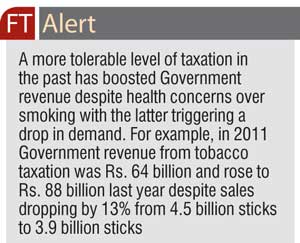Tuesday Dec 16, 2025
Tuesday Dec 16, 2025
Wednesday, 21 December 2016 01:05 - - {{hitsCtrl.values.hits}}
The recent unprecedented spike in taxation on tobacco is estimated to have caused a near Rs. 15 billion loss in revenue for the Government in the fourth quarter of this year and a staggering Rs. 25 billion in 2017, according to industry analysts.
They said that the revenue loss was due to the sale of cigarettes plunging by almost 50% in recent months after the Government drastically raised prices.
Due to the upward revision in Excise and 15% VAT, the prices of cigarettes increased by 82% for the low-end brand Capstan and 36% for Bristol. The premium yet fastest growing brand Dunhill saw its price shooting up by 45% and popular brand Gold Leaf by 43%.
Resultantly, monthly cigarette sales have dropped to 150 million sticks in October and November as against a 330 million monthly average between January and September.
Industry analysts described the recent revision in taxation as “merciless” whereas in the past it was conducted in stages and tolerable.
The drastic move by the Government, which some say is largely motivated by revenue considerations rather than health concerns, appears to be revenue-negative judging by the losses reported.
As opposed to Rs. 8.3 billion in revenue on average per month from January-September this year, the Treasury is estimated to have lost Rs. 4.2 billion in revenue in October and a further Rs. 4.8 billion in November. A Rs. 6 billion loss is forecast for December.
These estimates have prompted industry analysts to predict that in the final quarter of this year the revenue loss for the Government will be nearly Rs. 15 billion. This drop is expected to shrink the estimated revenue from tobacco for the entirety of 2016 by Rs. 10 billion-Rs. 90 billion. Previously, prior to the recent revisions, estimated State revenue from tobacco taxation was Rs. 100 billion for 2016 up from Rs. 88 billion in 2015.
A more tolerable level of taxation in the past has boosted Government revenue despite health concerns over smoking with the latter triggering a drop in demand. For example, in 2011 Government revenue from tobacco taxation was Rs. 64 billion and rose to Rs. 88 billion last year despite sales dropping by 13% from 4.5 billion sticks to 3.9 billion sticks.
Analysts said if the Government had pursued a more pragmatic taxation policy, revenue to the Treasury from tobacco would have increased to Rs. 110 billion next year and to Rs. 146 billion by 2020.
Industry analysts’ forecast of a loss in revenue comes hot on the heels of Finance Minister Ravi Karunanayake last week emphasising that overall Government collection had increased considerably.
In a statement last week, Karunanayake said overall Government revenue for the first nine months of 2016 had increased from Rs. 959 billion to Rs. 1,180 billion. “Income tax revenue in particular increased and public revenue as a percentage of GDP that was only 11% will increase to 13.5% by the end of the year,” the statement said.
Important revenue collecting organisations such as the Excise Department, Inland Revenue Department and Customs were highlighted in the media statement as being responsible for improved performance of public finance, according to Finance Minister Karunanayake.
Analysts said a drastic increase in prices had forced smokers to switch to non-revenue generating alternatives such as Beedi and smuggled cigarettes. Recent detections by Customs on the latter offer evidence of a new lease of life for cigarette smugglers following the Government hike in prices.
The 50% drop in sales has also forced the Ceylon Tobacco Company to review the future operations of four of its leaf depots including in Anuradhapura and Sigiriya. The downturn in sales has also impacted traders and farmers reliant on the tobacco industry.